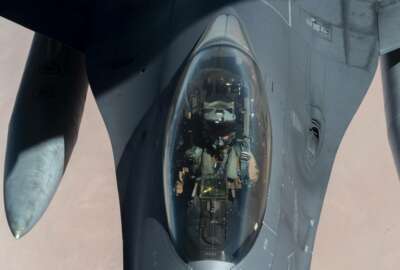Air Mobility Command learns to provide support ‘at the speed of data’
Advanced battle management system (ABMS) is the Air Force’s main contribution to DoD’s Joint All-Domain Command and Control (JADC2) vision of interconnected...
The Air Force recently announced that it will modify its KC-46 aerial refueling tankers to host its Advanced Battle Management System (ABMS) to become flying “hotspots” that can offload new data to F-22 and F-35 fighters at the same time they’re receiving fuel.
Lt. Gen. Brian Robinson, deputy commander of the Air Mobility Command, said pilots during the recent exercise Mobility Guardian called the increased situational awareness from ABMS “game changing.”
ABMS is the Air Force’s main contribution to DoD’s Joint All-Domain Command and Control (JADC2) vision of interconnected military systems.
“We did learn for one, what it takes to field the right equipment to be part of that architecture, so that it’s useful,” Robinson said during a recent Defense News webcast. “We also had commentary from some of the receiver aircraft, A-10s in this case, and having the tanker on Link 16 was ‘game changing’ from the receiver perspective, because today, a lot of that situational awareness with mobility aircraft is gleaned through what we call voice wrap or voice reports. So it’s human beings in the command and control nodes, and aircrew amongst aircrew relaying, via push to talk radio, the situation. And then you have to write it down on a piece of paper or a chart, that you have to build a visual depiction of a situational awareness they’re dealing with so we learned that that’s actually value added, it actually reduces the workload for all involved.”
He said it also gives mission commanders on the ground a near-realtime situational awareness of what’s going on around them. And that situational awareness extends out as far as a feed can be broadcast. Even warfighters who can’t maintain direct connectivity to the command and control node still get enough information to make better decisions to keep the mission on track.
Robinson said placing the ABMS system on the KC-46 tankers is a marriage of functionality and convenience. The tanker’s presence in operations like this is required, he said, to allow those fighters to reach their mission. So it’s conveniently already on site during the mission. But it also has the perfect size, weight and power to carry the hardware required to link the ABMS system to its space-based components while providing an alternate path to connectivity.
“That tanker can also, because of its size, carry what we’re talking about: Edge computing. So it has enough processing power on board, if it gets disconnected, the processing power onboard can store that data,” Robinson said. “So as a fighter pulls up for receiving fuel from the tanker for its mission, it can pass information that it has, if the link is broken, to the tanker that can then store it or transmit it through the capabilities that it has on ABS construct. As well as anything received to the tanker, in between refuelings, it can also pass information back to the fighters as well, that they can take onboard and with their systems figure out the most optimal way to prosecute their mission.”
He said ideally, he wants every one of Air Mobility Command’s aircraft equipped to handle this system. Due to fiscal realities, that probably isn’t possible, but Robinson said he intends to buy as many as he can. His target for installing this equipment is the fourth quarter of fiscal 2022.
Air Mobility Command has been angling to become the earliest adopters of this system since late last year.
“Air Mobility Command … is one of most forward-leaning commands we have in JADC2 thinking, and they are ready to go put [ABMS capabilities] on mobility platforms so they can act as data relays,” Will Roper, the then-Air Force acquisition chief said in November. “We’ve got tankers that top you up with gas, the vision of topping you up with data makes a lot of sense: You’re going to be there anyway to get fuel. And then that tanker standing off also can act as a battlefield relay and a network node. So they’ve got the right thinking.”
Robinson said this is a natural extension of the supportive mission of Air Mobility Command.
“When you’re in a position like we are where we support 10 other combatant commands and their components, we have to have a robust and persistent understanding of what’s most important to whom, when and why, and how that links back to the overall strategy or campaign, if you will,” he said. “And that’s what we do pretty well, right now, but we’re going to have to get better at it. We’re going to have to be able to do that at the speed of data. Because right now, we don’t necessarily do that. We use data, but not in a near real time fashion.”
The KC-46 project is known as “Capability Release 1,” and the initial work is part of $170 million the Air Force has allocated for ABMS this year.
Copyright © 2025 Federal News Network. All rights reserved. This website is not intended for users located within the European Economic Area.
Daisy Thornton is Federal News Network’s digital managing editor. In addition to her editing responsibilities, she covers federal management, workforce and technology issues. She is also the commentary editor; email her your letters to the editor and pitches for contributed bylines.
Follow @dthorntonWFED






